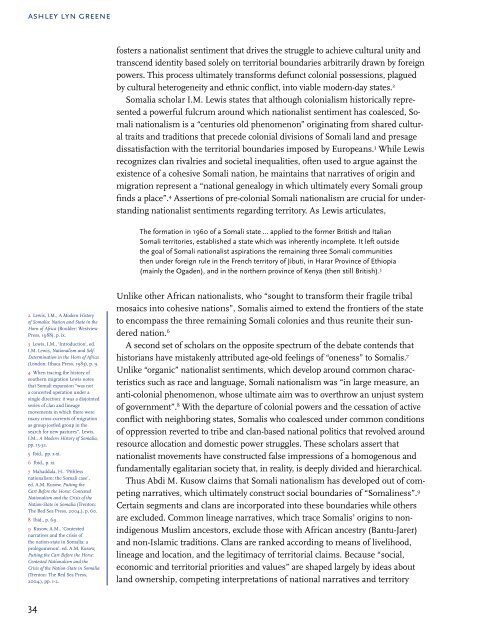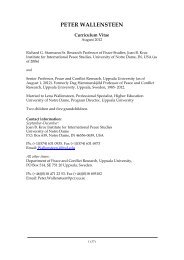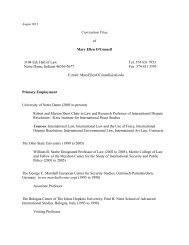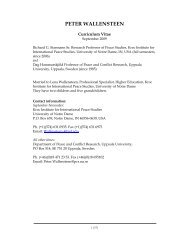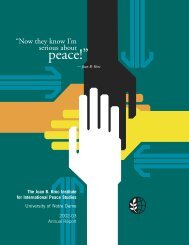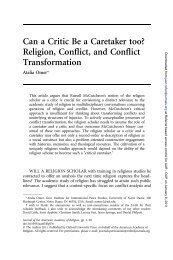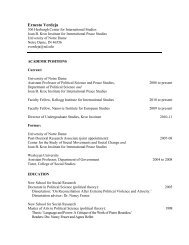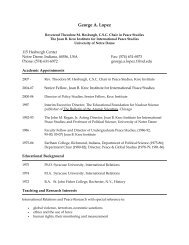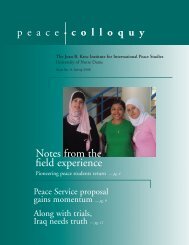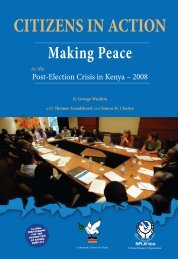Somalia: Creating Space for Fresh Approaches to Peacebuilding
Somalia: Creating Space for Fresh Approaches to Peacebuilding
Somalia: Creating Space for Fresh Approaches to Peacebuilding
You also want an ePaper? Increase the reach of your titles
YUMPU automatically turns print PDFs into web optimized ePapers that Google loves.
ashley lyn greene<br />
2 Lewis, I.M., A Modern His<strong>to</strong>ry<br />
of <strong>Somalia</strong>: Nation and State in the<br />
Horn of Africa (Boulder: Westview<br />
Press, 1988), p. ix.<br />
3 Lewis, I.M., ‘Introduction’, ed.<br />
I.M. Lewis, Nationalism and Self-<br />
Determination in the Horn of Africa<br />
(London: Ithaca Press, 1983), p. 9.<br />
4 When tracing the his<strong>to</strong>ry of<br />
southern migration Lewis notes<br />
that Somali expansion “was not<br />
a concerted operation under a<br />
single direction: it was a disjointed<br />
series of clan and lineage<br />
movements in which there were<br />
many cross-currents of migration<br />
as group jostled group in the<br />
search <strong>for</strong> new pastures”. Lewis,<br />
I.M., A Modern His<strong>to</strong>ry of <strong>Somalia</strong>,<br />
pp. 15-32.<br />
5 Ibid., pp. x-xi.<br />
6 Ibid., p. xi.<br />
7 Mahaddala, H., ‘Pithless<br />
nationalism: the Somali case’,<br />
ed. A.M. Kusow, Putting the<br />
Cart Be<strong>for</strong>e the Horse: Contested<br />
Nationalism and the Crisis of the<br />
Nation-State in <strong>Somalia</strong> (Tren<strong>to</strong>n:<br />
The Red Sea Press, 2004.), p. 60.<br />
8 Ibid., p. 69.<br />
9 Kusow, A.M., ‘Contested<br />
narratives and the crisis of<br />
the nation-state in <strong>Somalia</strong>: a<br />
prolegomenon’, ed. A.M. Kusow,<br />
Putting the Cart Be<strong>for</strong>e the Horse:<br />
Contested Nationalism and the<br />
Crisis of the Nation-State in <strong>Somalia</strong><br />
(Tren<strong>to</strong>n: The Red Sea Press,<br />
2004.), pp. 1-2.<br />
34<br />
fosters a nationalist sentiment that drives the struggle <strong>to</strong> achieve cultural unity and<br />
transcend identity based solely on terri<strong>to</strong>rial boundaries arbitrarily drawn by <strong>for</strong>eign<br />
powers. This process ultimately trans<strong>for</strong>ms defunct colonial possessions, plagued<br />
by cultural heterogeneity and ethnic conflict, in<strong>to</strong> viable modern-day states. 2<br />
<strong>Somalia</strong> scholar I.M. Lewis states that although colonialism his<strong>to</strong>rically represented<br />
a powerful fulcrum around which nationalist sentiment has coalesced, Somali<br />
nationalism is a “centuries old phenomenon” originating from shared cultural<br />
traits and traditions that precede colonial divisions of Somali land and presage<br />
dissatisfaction with the terri<strong>to</strong>rial boundaries imposed by Europeans. 3 While Lewis<br />
recognizes clan rivalries and societal inequalities, often used <strong>to</strong> argue against the<br />
existence of a cohesive Somali nation, he maintains that narratives of origin and<br />
migration represent a “national genealogy in which ultimately every Somali group<br />
finds a place”. 4 Assertions of pre-colonial Somali nationalism are crucial <strong>for</strong> understanding<br />
nationalist sentiments regarding terri<strong>to</strong>ry. As Lewis articulates,<br />
The <strong>for</strong>mation in 1960 of a Somali state … applied <strong>to</strong> the <strong>for</strong>mer British and Italian<br />
Somali terri<strong>to</strong>ries, established a state which was inherently incomplete. It left outside<br />
the goal of Somali nationalist aspirations the remaining three Somali communities<br />
then under <strong>for</strong>eign rule in the French terri<strong>to</strong>ry of Jibuti, in Harar Province of Ethiopia<br />
(mainly the Ogaden), and in the northern province of Kenya (then still British). 5<br />
Unlike other African nationalists, who “sought <strong>to</strong> trans<strong>for</strong>m their fragile tribal<br />
mosaics in<strong>to</strong> cohesive nations”, Somalis aimed <strong>to</strong> extend the frontiers of the state<br />
<strong>to</strong> encompass the three remaining Somali colonies and thus reunite their sundered<br />
nation. 6<br />
A second set of scholars on the opposite spectrum of the debate contends that<br />
his<strong>to</strong>rians have mistakenly attributed age-old feelings of “oneness” <strong>to</strong> Somalis. 7<br />
Unlike “organic” nationalist sentiments, which develop around common characteristics<br />
such as race and language, Somali nationalism was “in large measure, an<br />
anti-colonial phenomenon, whose ultimate aim was <strong>to</strong> overthrow an unjust system<br />
of government”. 8 With the departure of colonial powers and the cessation of active<br />
conflict with neighboring states, Somalis who coalesced under common conditions<br />
of oppression reverted <strong>to</strong> tribe and clan-based national politics that revolved around<br />
resource allocation and domestic power struggles. These scholars assert that<br />
nationalist movements have constructed false impressions of a homogenous and<br />
fundamentally egalitarian society that, in reality, is deeply divided and hierarchical.<br />
Thus Abdi M. Kusow claims that Somali nationalism has developed out of competing<br />
narratives, which ultimately construct social boundaries of “Somaliness”. 9<br />
Certain segments and clans are incorporated in<strong>to</strong> these boundaries while others<br />
are excluded. Common lineage narratives, which trace Somalis’ origins <strong>to</strong> non-<br />
indigenous Muslim ances<strong>to</strong>rs, exclude those with African ancestry (Bantu-Jarer)<br />
and non-Islamic traditions. Clans are ranked according <strong>to</strong> means of livelihood,<br />
lineage and location, and the legitimacy of terri<strong>to</strong>rial claims. Because “social,<br />
economic and terri<strong>to</strong>rial priorities and values” are shaped largely by ideas about<br />
land ownership, competing interpretations of national narratives and terri<strong>to</strong>ry


